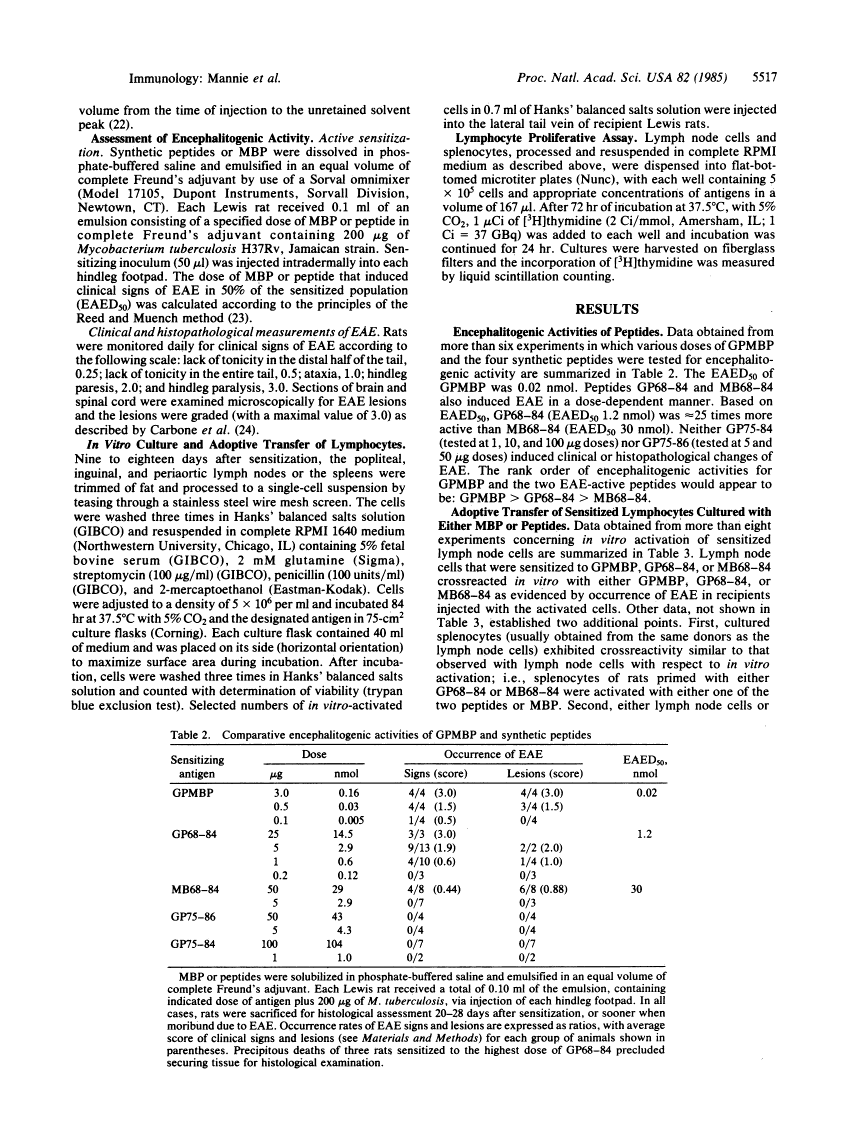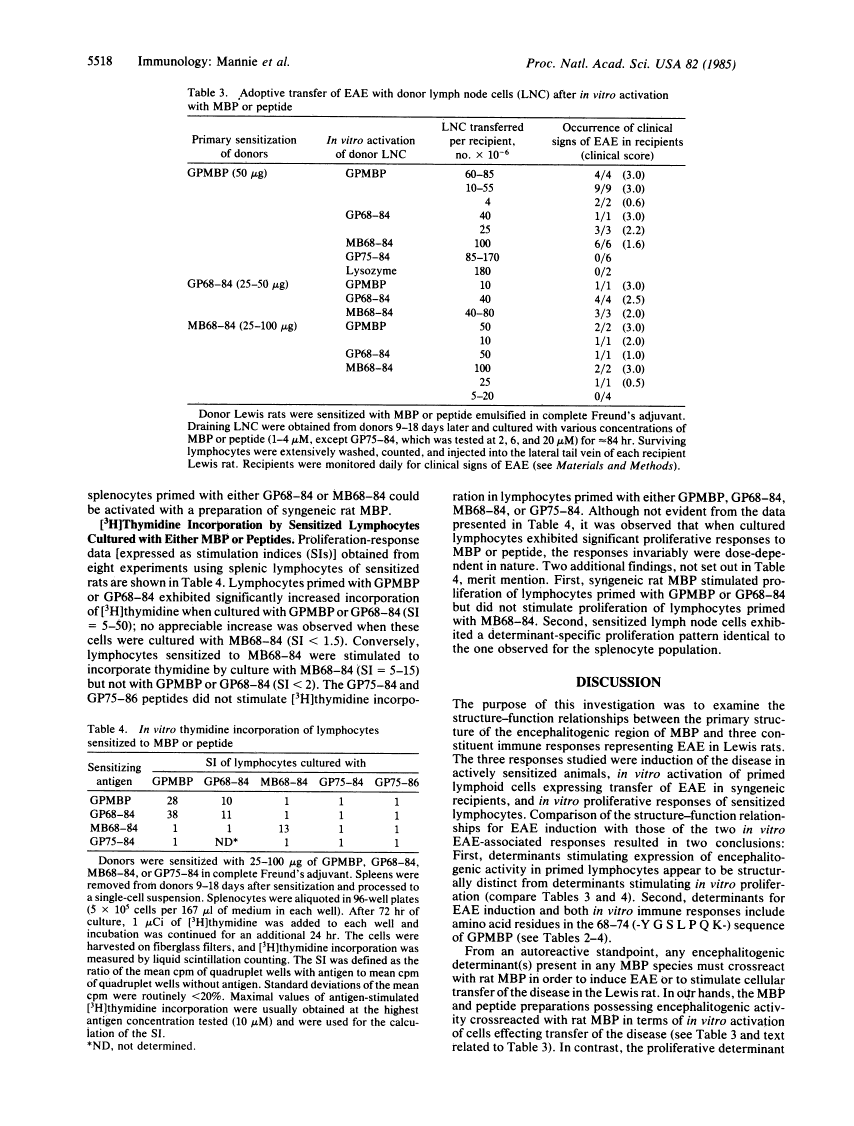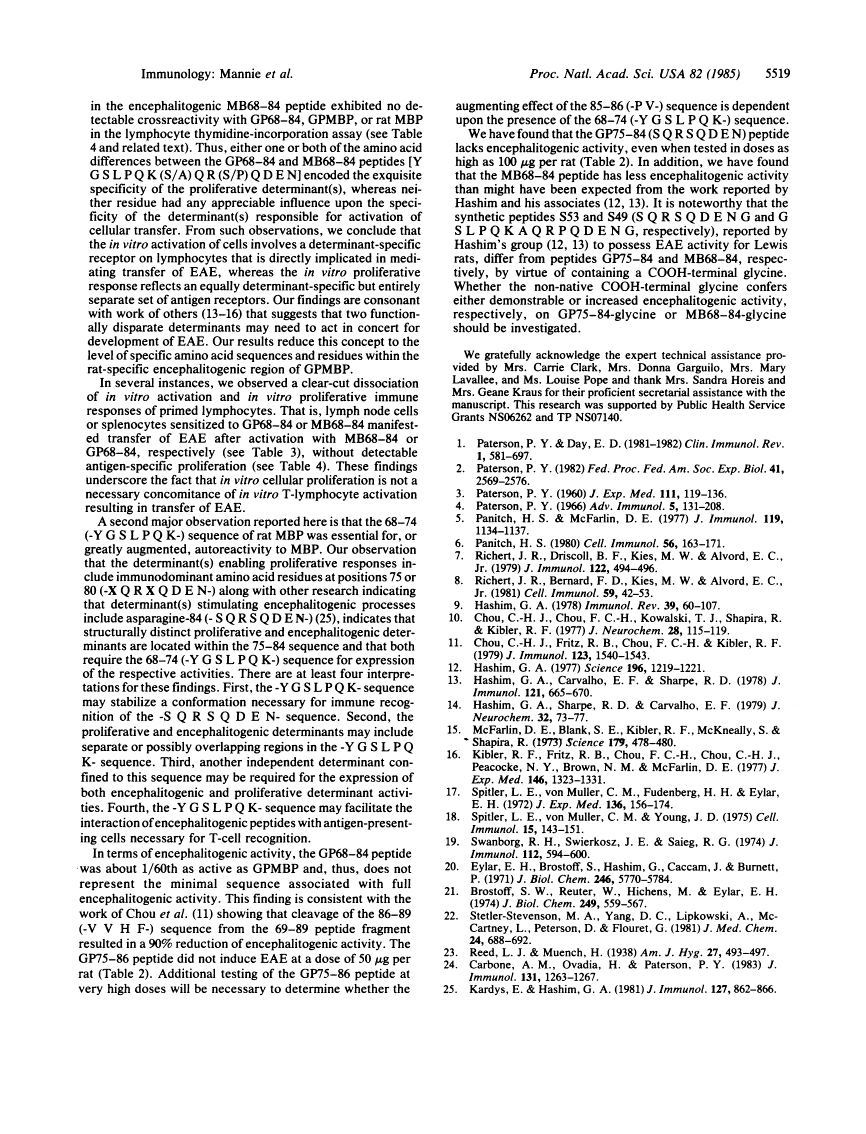Abstract
Free full text

Induction of experimental allergic encephalomyelitis in Lewis rats with purified synthetic peptides: delineation of antigenic determinants for encephalitogenicity, in vitro activation of cellular transfer, and proliferation of lymphocytes.
Abstract
Four highly purified synthetic peptides encompassing segments of the 68-86 region [for the numbering system used, see Eylar, E.H., Brostoff, S., Hashim, G., Caccam, J. & Burnett, P. (1971) J. Biol. Chem. 246, 5770-5784] of myelin basic protein (MBP), a region known to induce experimental allergic encephalomyelitis (EAE) in Lewis rats, were used to define and compare structure-function relationships between the primary structure of the 68-86 sequence and the three following biological activities: induction of EAE in Lewis rats, stimulation of T lymphocytes in vitro as measured by augmented cellular transfer of EAE to syngeneic recipients, and lymphocyte proliferation, as measured by [3]thymidine incorporation. Guinea pig (GP) MBP was approximately 60 or 1500 times more active than the GP68-84 (Y G S L P Q K S Q R S Q D E N; single-letter amino acid abbreviations) or the modified bovine (MB) 68-84 (Y G S L P Q K A Q R P Q D E N) peptides for induction of EAE, respectively. Furthermore, lymphocytes primed with either GPMBP, GP68-84, or MB68-84 crossreacted in vitro with either GPMBP, GP68-84, or MB68-84 for activation of lymphocyte transfer activity. In contrast, lymphocytes primed with either GP68-84 or MB68-84 exhibited antigen-specific proliferation in vitro exclusively in response to either GP or MB sequences, respectively. Neither GP75-84 (S Q R S Q D E N) nor GP75-86 (S Q R S Q D E N P V) induced EAE, activated lymphocytes for EAE transfer, or stimulated lymphocyte proliferation under conditions and doses tested. We conclude that (i) structurally distinct determinants, reflecting existence of functionally independent classes of antigen receptors, specify encephalitogenic and proliferative responses of primed lymphocytes and (ii) determinants for EAE induction, cellular transfer of EAE, and lymphocyte proliferation include amino acid residues in the 68-74 (Y G S L P Q K) sequence of GPMBP.
Full text
Full text is available as a scanned copy of the original print version. Get a printable copy (PDF file) of the complete article (1.1M), or click on a page image below to browse page by page. Links to PubMed are also available for Selected References.
Selected References
These references are in PubMed. This may not be the complete list of references from this article.
- Paterson PY, Day ED. Current perspectives of neuroimmunologic disease: multiple sclerosis and experimental allergic encephalomyelitis (1,2). Clin Immunol Rev. 1981;1(4):581–697. [Abstract] [Google Scholar]
- Paterson PY. Molecular and cellular determinants of neuroimmunologic inflammatory disease. Fed Proc. 1982 Jul;41(9):2569–2576. [Abstract] [Google Scholar]
- PATERSON PY. Transfer of allergic encephalomyelitis in rats by means of lymph node cells. J Exp Med. 1960 Jan 1;111:119–136. [Europe PMC free article] [Abstract] [Google Scholar]
- Paterson PY. Experimental allergic encephalomyelitis and autoimmune disease. Adv Immunol. 1966;5:131–208. [Abstract] [Google Scholar]
- Panitch HS, McFarlin DE. Experimental allergic encephalomyelitis: enhancement of cell-mediated transfer by concanavalin A. J Immunol. 1977 Sep;119(3):1134–1137. [Abstract] [Google Scholar]
- Panitch HS. Adoptive transfer of experimental allergic encephalomyelitis with activated spleen cells: comparison of in vitro activation by concanavalin a and myelin basic protein. Cell Immunol. 1980 Nov;56(1):163–171. [Abstract] [Google Scholar]
- Richert JR, Driscoll BF, Kies MW, Alvord EC., Jr Adoptive transfer of experimental allergic encephalomyelitis: incubation of rat spleen cells with specific antigen. J Immunol. 1979 Feb;122(2):494–496. [Abstract] [Google Scholar]
- Richert JR, Driscoll BF, Kies MW, Alvord EC., Jr Experimental allergic encephalomyelitis: activation of myelin basic protein-sensitized spleen cells by specific antigen in culture. Cell Immunol. 1981 Mar 15;59(1):42–53. [Abstract] [Google Scholar]
- Hashim GA. Myelin basic protein: structure, function and antigenic determinants. Immunol Rev. 1978;39:60–107. [Abstract] [Google Scholar]
- Chou CH, Chou FC, Kowalski TJ, Shapira R, Kibler RF. The major site of guinea-pig myelin basic protein encephalitogenic in Lewis rats. J Neurochem. 1977 Jan;28(1):115–119. [Abstract] [Google Scholar]
- Chou CH, Fritz RB, Chou FC, Kibler RF. The immune response of Lewis rats to peptide 68-88 of guinea pig myelin basic protein. I. T cell determinants. J Immunol. 1979 Oct;123(4):1540–1543. [Abstract] [Google Scholar]
- Hashim GA. Experimental allergic encephalomyelitis in Lewis rats: chemical synthesis of disease-inducing determinant. Science. 1977 Jun 10;196(4295):1219–1221. [Abstract] [Google Scholar]
- Hashim GA, Carvalho EF, Sharpe RD. Definition and synthesis of the essential amino acid sequence for experimental allergic encephalomyelitis in Lewis rats. J Immunol. 1978 Aug;121(2):665–670. [Abstract] [Google Scholar]
- Hashim GA, Sharpe RD, Carvalho EF. Experimental allergic encephalomyelitis: sequestered encephalitogenic determinant in the bovine myelin basic protein. J Neurochem. 1979 Jan;32(1):73–77. [Abstract] [Google Scholar]
- McFarlin DE, Blank SE, Kibler RF, McKneally S, Shapira R. Experimental allergic encephalomyelitis in the rat: response to encephalitogenic proteins and peptides. Science. 1973 Feb 2;179(4072):478–480. [Abstract] [Google Scholar]
- Kibler RF, Fritz RB, Chou F, Jen Chou C-H, Peacocke NY, Brown NM, McFarlin DE. Immune response of Lewis rats to peptide C1 (residues 68-88) of guinea pig and rat myelin basic proteins. J Exp Med. 1977 Nov 1;146(5):1323–1331. [Europe PMC free article] [Abstract] [Google Scholar]
- Spitler LE, Von Muller CM, Fudenberg HH, Eylar EH. Experimental allergic encephalitis. Dissociation of cellular immunity to brain protein and disease production. J Exp Med. 1972 Jul 1;136(1):156–174. [Europe PMC free article] [Abstract] [Google Scholar]
- Spitler LE, von Muller CM, Young JD. Experimental allergic encephalitis: study of cellular immunity to the encephalitogenic determinant. Cell Immunol. 1975 Jan;15(1):143–151. [Abstract] [Google Scholar]
- Swanborg RH, Swierkosz JE, Saieg RG. Studies on the species-variability of experimental allergic encephalomyelitis in guinea pigs and rats. J Immunol. 1974 Feb;112(2):594–600. [Abstract] [Google Scholar]
- Eylar EH, Brostoff S, Hashim G, Caccam J, Burnett P. Basic A1 protein of the myelin membrane. The complete amino acid sequence. J Biol Chem. 1971 Sep 25;246(18):5770–5784. [Abstract] [Google Scholar]
- Brostoff SW, Reuter W, Hichens M, Eylar EH. Specific cleavage of the A1 protein from myelin with cathepsin D. J Biol Chem. 1974 Jan 25;249(2):559–567. [Abstract] [Google Scholar]
- Stetler-Stevenson MA, Yang DC, Lipkowski A, McCartney L, Peterson D, Flouret G. An approach to the elucidation of metabolic breakdown products of the luteinizing hormone-releasing hormone. J Med Chem. 1981 Jun;24(6):688–692. [Abstract] [Google Scholar]
- Carbone AM, Ovadia H, Paterson PY. Role of macrophage-myelin basic protein interaction in the induction of experimental allergic encephalomyelitis in Lewis rats. J Immunol. 1983 Sep;131(3):1263–1267. [Abstract] [Google Scholar]
- Kardys E, Hashim GA. Experimental allergic encephalomyelitis in Lewis rats: immunoregulation of disease by a single amino acid substitution in the disease-inducing determinant. J Immunol. 1981 Sep;127(3):862–866. [Abstract] [Google Scholar]
Associated Data
Articles from Proceedings of the National Academy of Sciences of the United States of America are provided here courtesy of National Academy of Sciences
Full text links
Read article at publisher's site: https://doi.org/10.1073/pnas.82.16.5515
Read article for free, from open access legal sources, via Unpaywall:
https://europepmc.org/articles/pmc391153?pdf=render
Citations & impact
Impact metrics
Citations of article over time
Article citations
Early urinary candidate biomarkers and clinical outcomes of intervention in a rat model of experimental autoimmune encephalomyelitis.
R Soc Open Sci, 10(8):230118, 23 Aug 2023
Cited by: 3 articles | PMID: 37621667 | PMCID: PMC10445012
Animal models of multiple sclerosis: From rodents to zebrafish.
Mult Scler, 25(3):306-324, 15 Oct 2018
Cited by: 51 articles | PMID: 30319015
Review
Differences in peripheral myelin antigen-specific T cell responses and T memory subsets in atypical versus typical CIDP.
BMC Neurol, 17(1):81, 26 Apr 2017
Cited by: 14 articles | PMID: 28446142 | PMCID: PMC5406908
Anti-nuclear antibodies positive serum from systemic lupus erythematosus patients promotes cardiovascular manifestations and the presence of human antibody in the brain.
J Pharm Bioallied Sci, 6(3):198-204, 01 Jul 2014
Cited by: 2 articles | PMID: 25035640 | PMCID: PMC4097934
Myelin basic protein undergoes a broader range of modifications in mammals than in lower vertebrates.
J Proteome Res, 11(10):4791-4802, 21 Sep 2012
Cited by: 15 articles | PMID: 22420465 | PMCID: PMC3612544
Go to all (49) article citations
Protocols & materials
Related Immune Epitope Information - Immune Epitope Database and Analysis Resource
Similar Articles
To arrive at the top five similar articles we use a word-weighted algorithm to compare words from the Title and Abstract of each citation.
Encephalitogenic and proliferative responses of Lewis rat lymphocytes distinguished by position 75- and 80-substituted peptides of myelin basic protein.
J Immunol, 142(8):2608-2616, 01 Apr 1989
Cited by: 26 articles | PMID: 2467932
The N- and C-terminal boundaries of myelin basic protein determinants required for encephalitogenic and proliferative responses of Lewis rat T cells.
J Neuroimmunol, 26(3):201-211, 01 Mar 1990
Cited by: 13 articles | PMID: 1689742
Interleukin 1 and myelin basic protein synergistically augment adoptive transfer activity of lymphocytes mediating experimental autoimmune encephalomyelitis in Lewis rats.
J Immunol, 138(12):4229-4235, 01 Jun 1987
Cited by: 25 articles | PMID: 2438337
Funding
Funders who supported this work.
NINDS NIH HHS (2)
Grant ID: TP NS07140
Grant ID: NS06262









